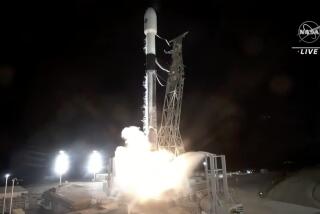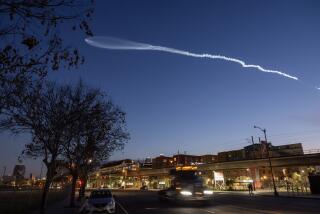NASA Is Asked to Bar Officials From Inquiry : Presidential Panel Head Says Decision Process Before Fatal Launch ‘May Have Been Flawed’
WASHINGTON — Citing indications that the decision-making process leading to the fatal launching of the Challenger shuttle “may have been flawed,” the head of a White House investigative panel asked NASA on Saturday to remove all launch-related officials from its internal task force analyzing the disaster.
Acting NASA Administrator William R. Graham promised complete cooperation with the request, and a Kennedy Space Center spokesman later said it “makes sense” to ensure that persons who made the launch decision are not investigating their own actions.
But NASA officials said privately that hundreds of key employees joined in the launch decision and that the request by William P. Rogers, chairman of the presidential commission on the Challenger accident, could force massive changes in the agency’s disaster inquiry.
‘Expect He Will Comply’
A spokesman for the White House panel said the request does not suggest that NASA is in any way “covering up” internal wrongdoing or that the agency has not cooperated with the probe. But the spokesman, Mark Weinberg, added that “we expect he (Graham) will comply” with what is officially termed a request, not an order.
Rogers asked Graham to change the NASA investigative team after the panel’s closed hearings at the Kennedy Space Center turned up evidence of prelaunch communications problems, a source familiar with the investigation said Saturday.
In a brief statement, Rogers said the panel “has been investigating all aspects of the decision-making process leading up to the launch of the Challenger and has found that the process may have been flawed.”
Graham “has been asked not to include on the internal investigating teams at NASA persons involved in that process,” the statement said, adding that President Reagan had been told of the request.
The panel now believes that fears for the integrity of O-ring seals in the Challenger’s solid-fuel booster rockets were not relayed to top NASA officials or were dismissed when they were relayed, said the source, who refused to be identified.
The commission has focused on an apparent leak in a right booster O-ring as the source of the jet of blazing rocket fuel that triggered the shuttle’s explosion. Aviation Week and Space Technology magazine reported Friday that NASA workers measured extremely low temperatures near the right booster before the launch but failed to relay the data to launch officials.
Lost Resiliency
The panel has theorized that the chilled O-ring lost its resiliency and failed to seal the booster’s fuel within the rocket when internal pressures rose dramatically at the moment of launch. That theory has been bolstered by photographs showing an ominous puff of black smoke that erupted at the booster’s side only a split second after the rocket began firing.
NASA on Saturday released dramatic new photographs showing a second burst of black smoke emerging from the booster about 47 seconds into the flight, followed by a “well-defined, intense plume” of exhaust streaming from the rocket’s side. Twenty-five seconds later, the shuttle exploded.
Neither NASA officials nor White House panel experts would say publicly whether prelaunch concerns about the boosters appear to have been severe enough to warrant canceling the launch.
‘Certain Qualms’
However, “there may have been people at various points in determining the flight readiness who raised certain qualms” about the boosters, the source familiar with the probe said. He declined to say who raised those concerns but said the panel questioned whether they “were given appropriate attention, whether they were passed along to high-enough levels of NASA officials and whether they were heeded to the extent they should have been.”
The panel wants to know “when were red flags raised and lowered and for what reasons and by whom,” the source said.
At the Kennedy Space Center, director of shuttle operations Robert B. Sieck said Rogers’ request came as a surprise, but that it “is obvious . . . they’ve uncovered what would appear to them some evidence that there was an error in the NASA process.”
NASA’s internal accident investigation team, the Data and Design Analysis Task Force, is headed by Jesse W. Moore, the agency’s top manned spaceflight official. The group has been deeply involved in most phases of the accident probe, from recovering fragments of the demolished spacecraft to analyzing telemetry and film from the shuttle’s final moments.
Space agency spokesman Shirley Green said Saturday that the task force has largely shied away from drawing conclusions about the cause of the accident, serving instead as an analyzing and investigating arm of Rogers’ White House panel.
NASA officials were unable Saturday to estimate the total number of people involved in the shuttle probe or the number of launch-related employees affected by it. “The NASA process governing an assessment for a launch goes very deep into the system,” Sieck said, “all the way to the contractor level.”
Difficult to Fulfill Request
Sieck said investigators probably could hire industry experts to continue the parts of the probe now conducted by NASA launch officials. But another NASA official, who declined to be identified, said Rogers’ request would be difficult to fulfill without clarification because “hundreds” of NASA workers have roles in deciding whether the shuttle can be safely launched.
Meanwhile, there was evidence Saturday that Challenger may have transmitted the sounds of its own explosion to controllers on the ground during the final instant of its flight.
Newly released telemetry data placed the time of the explosion at almost precisely the moment that a sharp, unidentified sound is heard on tapes of radio communications between Challenger and NASA’s Mission Control. The sound, heard about 3 seconds after shuttle commander Francis R. (Dick) Scobee’s last verbal transmission, consists of two clicks followed by a loud, roaring sound.
NASA spokesman Charles Redmond said Saturday in Washington that “it was my impression we were listening to the muffled sound of the explosion itself being carried through the circuit.” But many other NASA officials said they believe the sound is simply static.
No Evidence of Transmission
If the sound is that of the explosion, there is no clear evidence that Scobee was making a deliberate transmission, though he may have been, NASA officials said. Officials were uncertain Saturday whether the shuttle’s microphones were automatically activated by noise at that time or had to be activated by hand.
Transmissions from the shuttle crew at that phase of the flight are relatively rare, NASA spokesman George Diller said. But Diller said it was doubtful that the shuttle commander would have had any indication of a problem in time to tell ground controllers about it.
The orbiter’s microphones have three settings: voice activated, push-to-talk and live, a setting which broadcasts continually. Diller said the mike is normally positioned in the “push-to-talk” mode during launch. The voice-activated setting is typically used only during orbit activities, such as work in the cargo bay or a space walk, he said.
More to Read
Sign up for Essential California
The most important California stories and recommendations in your inbox every morning.
You may occasionally receive promotional content from the Los Angeles Times.










